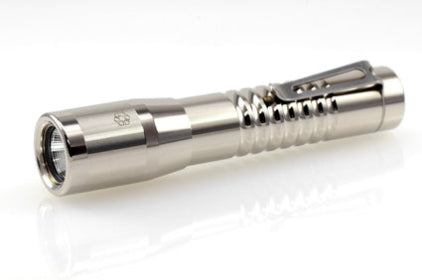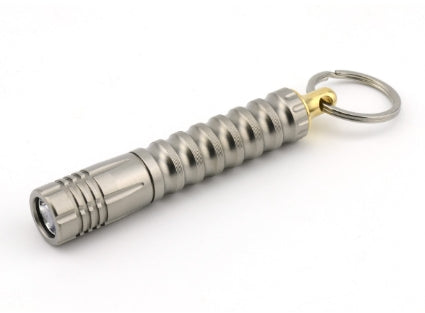Alpha Titanium (Stone Washed)
 1x18650 |
 Buyer's Choice |
 650-750 |
 .5 |
 1.5 hr |
 270 hr |
Alpha Titanium lights are...Titanium. Need I say more? Alphas use CP2 (Commercially Pure) Titanium because it has 3x better thermal conductivity compared to alloyed titanium. This design is based on several itterations of the Alpha ICE (Integrated Cooling Elements). See how I shoehorned a fancy acronym to describe cooling fins? They also allow this Ti light to run an maximum power for longer, because we get the heat out of the LED.
Appearance The machining details on the head evolved over a number of different special editions of the Alpha ICE (Integrated Cooling Element). As always, I'm looking for balance and classic lines. The entire light is machined from solid Domestic CP2 Titanium bar stock. Ever try drilling a 3/4" hole 4" deep in titanium? Good times. We use a carbide insert drill that costs $600 and uses two cutting inserts that are about $30 each.
Thermal Conductivity Ah yes, thermal conductivity. We are producing a lot of lumens and that makes a lot of heat. Deep grooving on the head helps get heat out of the light and into the environmet as quickly as possible. Everyone is going to ask why this light is made from CP2 (Grade 2) titanium and not from 6Al/4V (Grade 5) titanium. Sure, 6/4 is stronger...but we are making a flashlight, not a fighter jet. Strength doesn't really matter when aluminum will do just fine.
What the flashlight maker should concern themselves with is thermal conductivity. CP2 titanium conducts heat 3x better than 6/4 titanium. End of discussion? If you are making a light with this much power out of 6/4 titanium then you don't know (or don't care) how to engineer a flashlight.
Notes on owning a CP2 Titainum light Titanium is a galling material; it wants to smear and not slide past itself. This means you aren't supposed to make threaded parts out of it. Stainless steel is the same. If you ever torque a stainless nut onto a stainless bolt you are never getting the two apart.
We can get away with this in a flashlight because there isn't a lot of torque applied. However, this does mean that proper thread lubrication is ESSENTIAL. If you aren't the type to maintain your lights on a regular basis (clean/lube) then don't buy this light, you won't be happy with it.
You should expect a signficant break-in period where the threads feel rough-ish. They will eventually burnish out and become smooth if you maintain proper lubrication. The head threads are pre-treated with an extremely heavy lubricant (Munky Spunk) that is an excelent anti-galling agent.
During the break in period you'll get a lot of black colored "carry-off" as the threads basically sand themselves smooth. If you feel and increase in thread roughness, wipe this away with a clean cloth, but do NOT degrease the threads. Apply Nano-Oil after wiping down. Continue to wipe and re-oil as needed.
You should feel improvement over the course of several weeks. You can "play" with the threads but don't try and excessively accelerate the break in process. Part of that is allowing the threads to rest and the oil to penetrate the surface.

















- Alpha Series light
- 1x18650 Foursevens 3400mAh Li-Ion (Protected)
- Battery Case
- XTAR MC1 Charger (Lithium-ion ONLY)

- Maintenance kit (Nano-Oil + replacement o-rings)
- O-ring removal tool with rubber grip
- Three extra button colors of your choice
- Switch Tool (Pronged tool to aid in removal of the switch and retaining ring. 3D printed in-house!)

- Spare UCL window (glass lens) Spare McClicky tailcap switch
-
LED TypeBuyer's Choice
-
battery type18650 lithium-ion
-
Weight6.6oz (188g) No Battery
-
Dimensions1.2" x 5.75" (body dia. is 1")
-
Voltage Range2.8V-4.2V
-
Beam Distance110m
-
Brightness LevelsFully User Programmable (Default is L/M/H)
-
Special ModesStrobe, Beacon, SOS (added via programming)
-
Body MaterialCP2 (Commercially Pure) Titanium
-
Window Glass98% transmission UCL glass (2 side AR coated)
-
Water ResistanceIPX8 (100m)
-
Included Accessories1cc Nano Oil + 2 O-rings
-
Where it's made




























